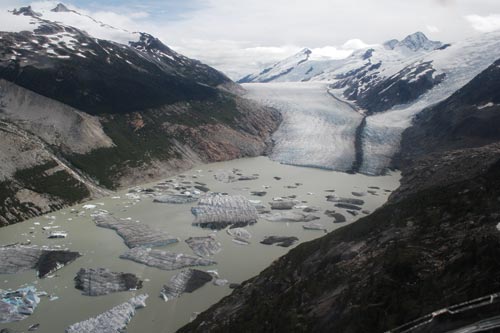In September 2007, Al and I visited Bishop Glacier, part of the Lillooet Icefield in the Pacific Ranges of Coast Mountains in southern British Columbia, near Vancouver. The Pacific Ranges are some of the largest coastal temperate icefields in the world—and they are breathtaking. They are also shocking first-hand evidence of what I’ve seen in slideshows and heard in dinner table conversations, from experts, scientists, policy makers, and leaders from around the world—that the increase in the earth’s temperature due to global warming is severely affecting the planet’s ice. From the Andes to the Alps, from Mount Kilimanjaro to Mount Fuji, our majestic rivers of ice are in danger of disappearing in this century. Icecaps like these serve the important function of feeding rivers and lakes; they are lifeblood of surrounding ecosystems—the wildlife and vegetation, but also people who live nearby.
As our helicopter flew in low over the glacier, I was struck by its otherworldly beauty, but the mountaintop’s sparkling whites, brilliant blues, and luminous greens belied the devastating story, gathering in a murky pool at the foot of these mountains. These rivers of ice, frozen for thousands, if not tens of thousands of years, are steadily thawing, exposing the bare rock underneath, rarely, if ever before, seen by humans. The fissures and crevasses are widening and deepening as the ice drips into the ever-growing lake of meltwater below. Unnaturally large floes of ice calve off, sometimes violently, crashing and cascading down the mountainside. If you happen to be there at just the right time, you can see global warming exacting its toll right before your eyes.
When friend and celebrated wildlife photographer James Balog saw these images, he was moved to include Bishop Glacier in the Extreme Ice Survey, a project to produce 300,000 time-lapse photos of fifteen glaciers in retreat across the Northern Hemisphere over the course of two years. Cameras are now positioned on both sides of this mountaintop, capturing glacial melt as never before—a daily visual record to document the dramatic signs of a planet in crisis.
I feel fortunate to have experienced the breathtaking beauty of this glacier, high in the mountains of British Columbia, and I only hope that others will have a chance to see it too. And even if it remains for most an expanse of ice beyond our field of vision, I hope we can save Bishop Glacier—and the countless glaciers like it, as well as the ecosystems and cultures that depend upon them—for ourselves and for the future.








